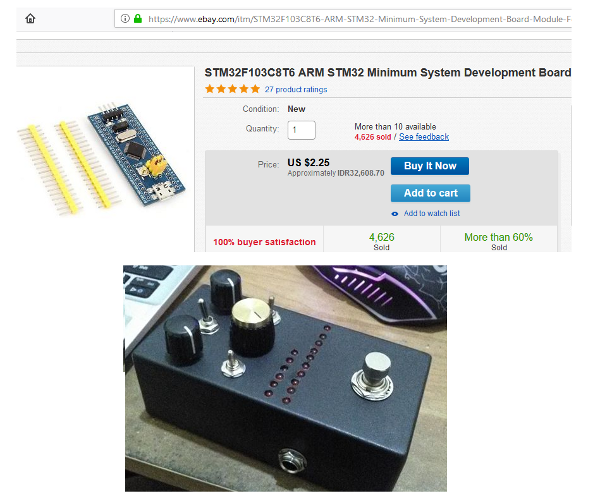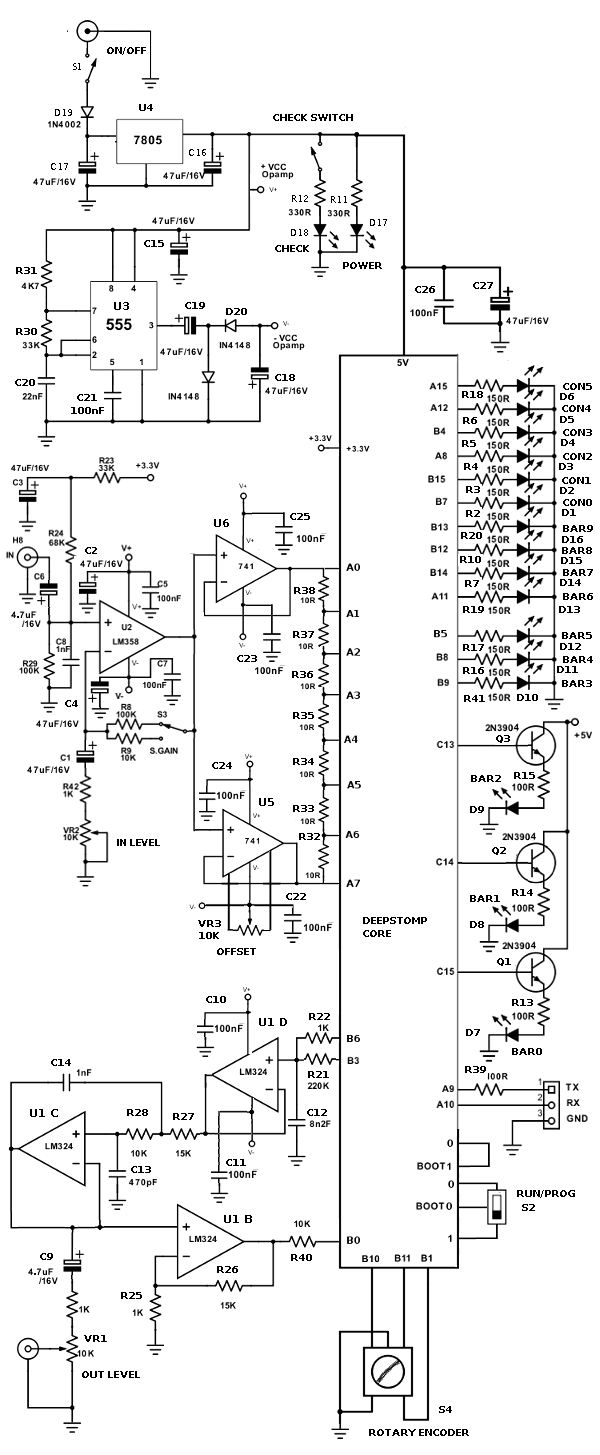DIY Multi-Effect Pedal Platform is Now Low-Cost!

DIY Multi-Effect Pedal and Today’s Advanced Electronics
Digital DIY multi-effect pedal is an expensive things in the past, but the advance of today’s digital electronics brings new hopes for many things. Because now there are many choices for low cost and high performance DSP microcontrollers, now I think we can implement a DIY multi-effect pedal with much lower cost than several years ago. For example, a small board, popularly called “blue-pill”, now is available on many online stores for only US$ 2.25 (Figure 1.-upper part). Although its price is very cheap, it has many advanced features. For example, its clock speed is 72MHz, the processor core is 32-bit, and the RAM size is 20kB. Additionally, the processor core supports some DSP instruction sets (ARM Cortex M3). After all, this chip contains many built-in peripheral: multi channel 12-Bit ADC (expandable to 15-bit by multi-channel oversampling), 4 PWM output, various communication peripherals, and many digital IO pins.
This ridiculously cheap development board is very tempting not only for just develop new product but also for embedding it into the final product as its core component. In order to take benefit of this digital technology for everyone, I had decided to design an open platform (open source hardware and software) for DIY digital multi effect stompbox/pedal which is based on “blue-pill” as its core, and I name it as Deepstomp. Although not yet perfect, now the hardware design is available at Deepstomp’s official website, and here is the schematic diagram of the current version (1.2), shown in the Figure 2.

DIY Multi-Effect Pedal Circuit’s Bill of The Materials
- Resistors
- VR1,2 ……………………………………………………………. 2 x 10K Potentiometer
- VR3 ……………………………………………………………….. 1 x 10K Multi-turn trimmer potentiometer
- R1,22,25 ……………………………………………………….. 3 x 1K
- R2,3,4,5,6,7,10,16,17,18,19,20,41 ……………. 13 x 150R
- R8,29 …………………………………………………………….. 2 x 100K
- R9,28,40………………………………………………………… 3 x 10K
- R11, R12 ………………………………………………………. 2 x 330R
- R13,14,15,39 ……………………………………………….. 4 x 100R
- R21 …………………………………………………………………1 x 220K
- R23, R30 ………………………………………………………. 2 x 33K
- R24 ………………………………………………………………… 1 x 68K
- R26,27 …………………………………………………………… 2 x 15K
- R31 ……………………………………………………………….. 1 x 4K7
- R32,33,34,35,36,37,38 ……………………………….. 7 x 10R
- Capacitors
- C1,2,3,4,15,16,17,18,19,27…………………………. 10 x 47uF/16V Electrolytic
- C5,7,10,11,21,22,23,24,25,26 ……………………. 10 x 100nF Mylar or 1uF Multilayer Ceramic
- C6,9 ……………………………………………………………….. 2 x 4u7/16V Electrolytic
- C20 …………………………………………………………………. 1 x 22nF Mylar
- C8,14 ……………………………………………………………… 2 x 1nF Mylar
- C12 …………………………………………………………………. 1 x 8n2 Mylar
- C13 …………………………………………………………………. 1 x 470pF Mylar
- Transistors
- Q1,2,3 ……………………………………………………………. 3 x 2N3904
- Diodes
- D19 ………………………………………………………………… 1 x 1N4002
- D20,21 …………………………………………………………… 2 x 1N4148
- D1,2,3,4,5,6,7,8,9,10,11,12,13,14,15,16,17,18 ……. 18 x LED (3 mm RED)
- Integrated Circuits (IC)
- U1 ………………………………………………………………….. 1 x LM324
- U2 ………………………………………………………………….. 1 x LM358
- U3 ………………………………………………………………….. 1 x 555
- U4 ………………………………………………………………….. 1 x 7805
- U5,6 ……………………………………………………………….. 2 x 741
- Switches
- S1,2,3 …………………………………………………………….. 3 x SPDT Toggle Switch
- S4 ……………………………………………………… Rotary Encoder with Push Button
- CHECK ………………………………………………………….. 1 x 3PDT Stomp Switch
- Connectors
- IN …………………………………………………………………….. 1 x Mono audio plug port
- OUT ………………………………………………………………… 1 x Mono audio plug port
- Serial Communication ………………………….. 1 x Stereo audio (3.5mm) plug port
- POWER ………………………………………………………….. 1 x DC power plug port
- CPU/Core board …………………………………………….. Blue-pill board compatible female header
Input/Output Conversion Depth
Firstly, the audio input/output conversion needs to be improved. Because it has built-in ADC and PWM generator, so it would be cheap if we can use it. Rather than adding external converters, using multichannel expansion oversampling on its 8 channel of 12-bit ADC should theoretically result in 15-bit final resolution. The output conversion is done using cascaded 8-bit PWM with automatic calibration to produce 16-bit resolution with no missing-steps nor over-steps error.
Power Supply
In order to comply with general pedal power supply, this DIY multi effect pedal circuit uses 9-12V DC power supply. Although the current consumption is just around 100 mA, we recommend to use at least 300 mA rated power supply adapter for reliability. A 555 IC provides the negative voltage to supply the operational amplifier inside the circuit. Unlike other effect pedal that has switch-crafted audio input plug socket, this pedal has a power-on toggle switch as the most convenient way to do power-on reset when dealing with the programming operation. In addition, a power safety feature for this circuit is provided by employing a protection diode. Consequently, any incorrect power supply polarity would never damage the circuit.
Intuitive User Interface
The main operational interface is one rotary (cw-ccw pulse) encoder with push-button function and two rows of LEDs. The first bar (6 LEDs) is the control indicator, while the second bar (10 LEDs) is the parameter value or signal indicator. When the platform runs a single effect application, then the 6-LED control indicator indicates the (up-to 6) parameters directly. In this mode, the 10-LED signal/value indicates the active parameter value. When the platform runs a multi-effect application, then the last two LEDs (5th-LED and 6th-LED) of the control indicator will always controls the preset and the module selector. Consequently, only 4 controls are available to control the 4 effect parameters (of the active/selected module).
LED Bar Display Modes
In order to provide various display mode, combination of single-LED and double-LED with continuous and blinking lights is used. As a result, the signal/value indicator can intuitively display any value from 0 to 9 in 10 steps, 19 steps, or 38 steps.
- Firstly, 10-Step Mode, one active LED will directly show the value (equal to its position)
- Secondly, 19-Step Mode, one or two LEDs will be activated to show a value from 0.0 to 9.0 in 19 steps. For example:
- 3.0 = LED3 (continuous)
- 3.5 = LED3 (continuous) + LED4 (continuous)
- 4.0 = LED4 (continuous)
- In addition, 38-Step Mode, a combination of one active LED or two active LEDs, with continuous or blinking lights, will indicate any a value from 0.00 to 9.00 in 38 steps. For example:
- 1.00 = LED1 (continuous)
- 1.25 = LED1 (continuous) + LED2 (blinking)
- 1.50 = LED1 (continuous) + LED2 (continuous)
- 1.75 = LED1 (blinking) + LED2 (continuous)
- 2.00 = LED2 (continuous)
- Lastly, chromatic notes display mode is also supported, and it would show any notes from C to B from the 1st to the 3rd octaves. A chromatic notes will be indicated by two activated LEDs, such as C#, will be indicated by LED0 (continuous) + LED1 (continuous). While the note indication is shown by one or two continuous light LED (of D0-D6), the octave position will be indicated by one blinking LED of LED7,LED8, and LED9.
Multi-Effect Implemented Features and Source Code Download
The current implemented features of this multi-effect pedal are:
- Chromatic guitar tuner
- Expansor, an integrated noise gate expander and compressor with synchronized gate-on level, gate-off level, compression-start, compression-stop, and compression factor, compression attack, and compression-release controls.
- Distortion, featured with overdrive mode, fuzz mode, and hi-lo tone control
- Delay, featured with time, feedback, and balance control
The source code of he platform’s core and its multi-effect implementation can be downloaded freely at github repositores.